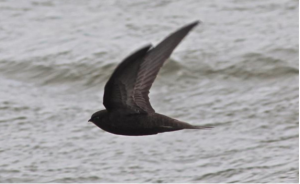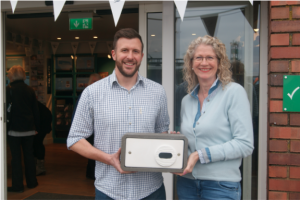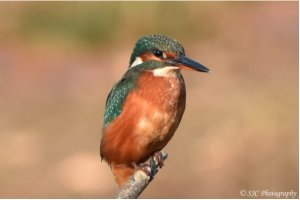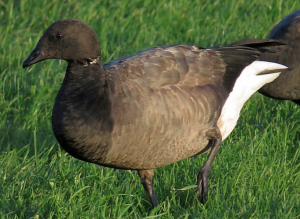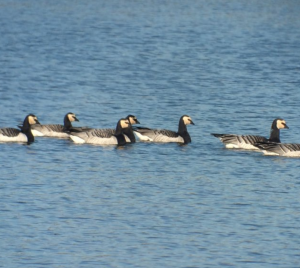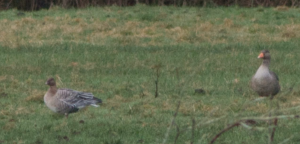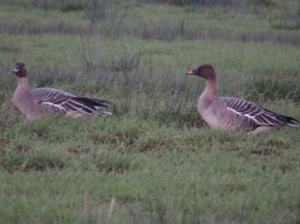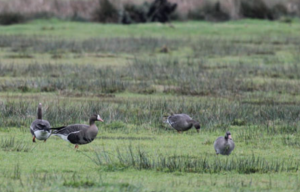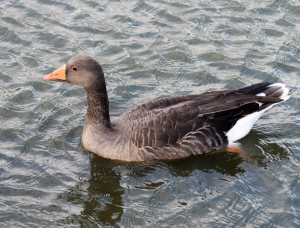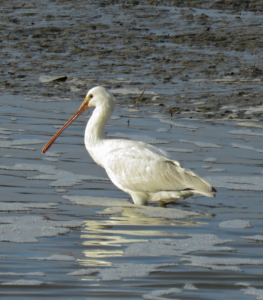With the last few summer migrants leaving the harbour in September and October, November and December are the start of winter birding!
Throughout the winter, Poole Harbour can see an additional two swan species in the harbour. It’s worth checking our resident Mute swan flocks at places such as Swineham, the Frome Valley, Lytchett Fields and Holes Bay for both Bewick Swans and Whooper Swans who are uncommon in the harbour. These swans are migratory with Bewick Swans arriving from the Russian tundra and Whooper Swans arriving from Iceland during October or January depending on the winter.
Wintering geese such as Dark-bellied Brent Geese arrive from late October in the west and east of the harbour before moving to areas such as Baiter Park, Middlebere, Brands Bay and Studland Bay. Dark-bellied Brent Geese arrive from Russia with Pale-bellied Brent Geese, a rarer subspecies in the south of the UK, arriving from Canada and generally turning up at Studland Bay. Another rarer wintering goose is the Greater White-fronted Goose. These geese generally feed on flooded grassland with previous records of Whitefronts generally heading to Arne, Middlebere or Bestwall or flying through the harbour entrance. There are two subspecies which could turn up, European White-fronted Geese breeding in Scandinavia and Russia and the Greenland White-fronted Goose arriving from Greenland and Arctic Canada.
Without most people knowing, ducks migrate too. Throughout the winter we could see up to 18 species of duck in the harbour with noticeable increases in resident ducks such as Mallard and Tufted Duck in Poole Park particularly. Teal and Wigeon begin to arrive from the end of August/September when most are moulting whereas the larger flocks of Shoveler, Gadwall and Shelducks arrive in October and November. Pintail and Pochard vary in numbers depending how cold continental Europe is with the main duck sites being Holes Bay, Upton Country Park, Middlebere, Brownsea Island, Lytchett Fields and Swineham. Wintering sea ducks such as Goldeneye and Red-breasted Mergansers turn up in October and November and easiest seen on Poole Park or in the harbour from one of our bird boats. There are also sporadic appearances of Common Scoter, Velvet Scoter, Long-tailed Duck, Common Eider and Greater Scaup in the central harbour or in Studland Bay between November and February. A lovely male Long-tailed Duck was seen from one of our Winter bird boat trips on November 25th 2018 on the south side of Brownsea with a small flock of five Eiders seen near Studland the day after, proving a good couple of days for ducks. Even though we have not had any yet this winter, Goosander and Smew records are uncommon with Swineham being the best location for both of these species.
Throughout October and November, Black-necked Grebes arrive from the continent and are seen off Studland Bay and the central harbour with late November/December seeing Great Northern Divers arrive back from Scandinavia. Divers are found in the deepest sections of Poole Harbour although they can turn up in Poole Park and Poole Quay. Continental Cormorants join the native Cormorants for the winter and are regularly seen in flocks of up to 400. It’s worth checking roosting Cormorants on exposed rocks as they can be mistaken for the smaller Shags which are resident throughout the UK, but some migrate to Poole in the winter.
A Poole harbour specialist is the Eurasian Spoonbill which arrive throughout August and build up into September and October. Throughout the winter they share their time between Brownsea Island and Arne but could turn up in Lytchett Bay or Holes Bay. Eurasian Bitterns turn up throughout November and seek the reedbeds around Swineham or (historically) Hatch Pond where they are best seen on frosty mornings.
Birds of prey migrate to Poole Harbour from Northern Britain or Scandinavia in late October/Early November. Hen Harriers, Merlin and Short-eared Owls prefer our heathlands when they arrive although sightings elsewhere of birds feeding and hunting are not rare. Merlin have been recently seen on Brownsea Island chasing waders and a Short-eared Owl was on Hartland Moor quartering the moorland through November.
Another specialised group of birds which arrive in Poole harbour is waders. Throughout the winter we can see up to 20 species which arrive from countries as far away as Iceland, Finland and Russia. Our wintering flock of Pied Avocets which turn up on Brownsea Lagoon and move between there and Middlebere breed mainly in the Netherlands but also SW France too and arrive here in September. Common Ringed Plover and Dunlin breed in the UK but most of the migrants are from Scandinavia or Iceland. Although we get large numbers of both species passing through in August and September, Ringed Plover generally winter near Baiter Park with Dunlin seen in most wetland areas and even flooded fields. Scandinavian breeding waders such as Grey Plover, Spotted Redshank and Greenshank winter on Brownsea Island passing through in the Autumn but overwintering anytime after October. Northern Lapwing and Common Redshank breed in small numbers within the harbour and across the UK on wetlands but larger, continental birds from Iceland and Scandinavia choose Brownsea Island, Holton Lee pools, Middlebere, Lytchett fields, Upton Country Park and Holes Bay to feed on the expanse of mud.
Waders from the Arctic such as Red Knot and Sanderling winter in small numbers in the harbour. Sanderling can be found at Shell Beach, Studland and Red Knot frequently are seen on Brownsea Island. About 70 Ruddy Turnstones turn up in Poole Harbour for the winter with the best sites being Baiter Park and Hamworthy Park where close views can be obtained. There is only one site where Purple Sandpipers occur, they are uncommon in the harbour but like the groynes and rocky outcrops around the Sandbanks chain ferry. Similarly, several Green Sandpiper have chosen Holton Lee Pools and Lytchett Fields to winter this year, the only sites in the harbour although many pass through from July-September. Bar and Black-tailed Godwits winter within the harbour. Bar-tailed Godwits are mainly restricted to Whitley Lake at Low tide and Brownsea Island at high tide with Black-tailed Godwits feeding in Holes Bay, Brownsea Lagoon and Lytchett Bay.
Curlew can be found across the harbour throughout the year with large gatherings at Shipstal point. The furthest most our ringed Curlew migrate from is as far as Finland and Germany boosting the winter population up to 2000 strong. Woodcock, Snipe and Jack snipe will all appear in Poole Harbour in small numbers, all migrating from northern Europe and Russia. Often seen flushed from under the observer’s feet, Snipe and Jack Snipe can be found in wet heathlands and water meadows bordering the harbour, and much of the woodland around the harbour holds Woodcock in the winter.
Rare Gull species can occur in the harbour during winter, Iceland gull and Glaucous gull are two notable species that have occurred in the past. The Iceland Gull has been recorded eight times in the last 15 years and sub-species Larus glaucoides kumlien which breed in Québec and Baffin Island, have been seen once. Glaucous Gull have only 21 records in the past 33 years and are mostly seen within the Studland and Brownsea area.
Common Guillemots breed on the cliffs of Durlston and spend most of their lives out to sea. In the winter they can be seen out from our coastlines wintering in the North Sea or Atlantic but are frequently seen in Poole Harbour and can offer some good views seen outside the mouth of the harbour and sometimes coming as far in as Poole Quay. Razorbill are also frequent in the harbour during the winter, and every few years the much scarcer Black Guillemot will make an appearance off the southern shore of Brownsea.
There’s an array of special migrant passerines to see during the winter in and around Poole Harbour. The lark-like pipits are on the move in the winter, Water Pipits are scarce seasonal visitors best seen at Wareham water meadows, Holton Pools, Lytchett Fields and the Wytch Causeway. Any wet marshy fields are best to look out for pipits on. Most Rock Pipit of the Anthus petrosus petrosus race are resident and a short distant migrant, but we do receive an influx of the Scandinavian race Anthus petrosus littoralis. Most Rock Pipits seen in Poole Harbour during the winter are likely Scandinavian, as seen in spring during moult and evidenced by ringing recoveries at Lytchett Bay.
Suspected to be determined by food supply in their Scandinavian summer distribution, Waxwing’s migration brings in varying abundances of birds each year. Every four to five years the UK seems to get large migrations feeding on rowan and hawthorn berries. Hopefully we will see some good numbers this winter, in the past Broadstone, Canford Heath and Parkstone have been favoured sites.
There are six thrush species that make frequent movements across the UK to settle for winter. Although our resident breeding population of Mistle thrush show little seasonal movement. Blackbird populations are boosted with migrants from mainland Europe. Song thrush can move in massive migrations across Europe which can be seen in the UK. Redwing and Song thrush often move in the same flock and can be heard at night from November onwards, with Redwing making a soft ‘zeeeeeep’ call and Song thrush making a ‘tic’ in between. Redwing, Fieldfare and Ring Ouzel are on migration from their breeding grounds in Scandinavia. Best spots in Poole Harbour to see flocks of thrushes are large fields or fruit bearing bushes. Although not a thrush, Brambling are of similar movements – breeding in Scandinavia and western Europe and flying to the UK to overwinter. Brambling use the area as passage on migration and have stayed to overwinter in the past, they are best seen in amongst other Chaffinch flocks such as at Arne, Middlebere and Greenlands Farm.
Great Grey Shrike can be found in any heathland around the harbour, but occurrences in the harbour each year are few. An individual has been in the area since 2nd November and has been sighted up until recently on Morden Bog. Sites where sightings have also been recorded in the past are Studland, Arne, Hartland Moor, Canford Heath, Upton Heath and Holton Lee/ Holton Heath NNR. This shrike breeds in Scandinavia and a small population overwinter UK.
Lesser Redpoll are another wonderful passerine winter visitor to see, social birds seen in decent flocks of 50 – 100, best seen at Studland, Arne, Upton Heath and Hartland during the winter. These birds are known to range and wander as flocks not particularly sticking to strict wintering grounds. Common and Arctic Redpolls are unlikely to see but not impossible with 2018 being a notable year so far for both species. The Black Redstart is a scarce winter visitor, often seen in urban settings on top of rooves and chimneys of buildings in place of the natural boulders and cliffs they would use in upland breeding territory. Ballard Down is best to see them in migration time but they also favour the Knoll/Middle Beach area, Arne Farm, Middlebere, Poole Quay, Old Town Poole and Sterte/Holes Bay.
In terms of rarities, the flock of Cattle Egrets which turned up in the Autumn are the rarest birds within Poole Harbour at the time of writing. If the weather remains mild and there is plenty of food for them to eat, there is a chance that these birds will remain into the Spring and possibly contribute to the establishment of a nearby breeding colony. With winter just beginning, why not explore the harbour and see some winter birds!
For more up to date news and bird information check our website for bird boat trips as well as the sightings page. If you are out birding or see something of interest do not forget to Tweet (@harbourbirds), message us on social media or pop into the HQ on Poole Quay.
| Species |
Status in Poole Harbour |
Most likely sites |
| Whooper Swan |
Rare winter visitor |
Holes Bay
Lytchett Bay
Frome Valley |
| Bewick Swan |
Uncommon winter visitor |
Frome Valley |
| European White-fronted Goose |
Rare winter visitor |
Bestwall, Swineham |
| Brent Goose |
Locally common winter visitor |
Baiter Park
South shores
Holes Bay
Arne RSPB
Studland Bay
Brownsea Island |
| Northern Pintail |
Locally common winter visitor |
Holes Bay
Upton country park
Brands Bay |
| Northern Shoveler |
Locally common winter visitor |
Holes Bay
Swineham Gravel Pits
Upton country park
Brownsea Island |
| Eurasian Wigeon |
Common winter visitor |
Holes Bay
Upton country park
Brownsea Island
Middlebere |
| Eurasian Teal |
Common winter visitor |
Holes Bay
Upton country park
Brownsea Island
Middlebere Channel |
| Common Pochard |
Declining winter visitor |
Poole Park, Swineham, Holes Bay |
| Greater Scaup |
Annual winter visitor |
Poole Park, Central Harbour, Swineham GP |
| Tufted Duck |
Locally common breeding resident and winter visitor |
Poole Park |
| Common Eider |
Regular winter visitor |
Brands Bay
Bramble Bush Bay
South Haven Point |
| Common Scoter |
Annual winter visitor |
Shell Bay, Studland |
| Long-tailed Duck |
Uncommon winter visitor |
Central Harbour, Brands Bay, South Deep, Studland Bay |
| Common Goldeneye |
Locally common winter visitor |
Central Harbour, Poole Park, Jerry’s point |
| Smew |
Scarce winter visitor |
Swineham GP, Poole Park, Holes Bay |
| Red-breasted Merganser |
Locally common winter visitor |
Central Harbour, Brands Bay, Poole Park |
| Goosander |
Uncommon winter visitor |
River Frome, River Piddle, Swineham, Wareham Channel |
| Great-northern Diver |
Uncommon winter visitor |
North Channel, Jerry’s point, Baiter Park |
| Black-necked Grebe |
Annual winter visitor |
Studland Bay
Shell Bay |
| European Shag |
Locally common winter visitor |
Poole Harbour entrance |
| Great Bittern |
Annual winter visitor |
Hatch Pond
Swineham
Middlebere
Arne
Lytchett fields |
| Eurasian Spoonbill |
Increasing winter visitor |
Shipstal Point, Brownsea Lagoon |
| Hen Harrier |
Localised winter visitor |
Middlebere, Lytchett Bay, Slepe Heath |
| Merlin |
Uncommon winter visitor |
Hartland Moor, Middlebere, Lytchett Bay |
| Short-eared Owl |
Uncommon winter visitor |
Hartland Moor, Slepe Heath, Middlebere |
| Pied Avocet |
Increasing winter visitor |
Brownsea Island
Middlebere
Lytchett Bay
Holes Bay
Arne bay |
| Common Ringed Plover |
Locally common winter visitor |
Baiter Park, Bramble bush Bay |
| Grey Plover |
Locally common winter visitor |
Brands Bay, Bramble bush Bay |
| Golden Plover |
Locally common winter visitor |
|
| Northern Lapwing |
Common winter visitor |
Middlebere, Lytchett Fields |
| Red Knot |
Uncommon winter visitor |
Brands Bay, Brownsea Lagoon |
| Sanderling |
Uncommon winter visitor |
Whitley Lake, Shell Bay |
| Purple Sandpiper |
Uncommon winter visitor |
North Haven, Sandbanks Groynes |
| Ruddy Turnstone |
Locally common winter visitor |
Baiter Beach, Poole Quay, Bramble Bush Bay |
| Dunlin |
Common winter visitor |
Brownsea Lagoon
Arne
Lytchett Fields
Yacht club mariners |
| Green Sandpiper |
Annual winter visitor |
Lytchett Fields, Holton Pools |
| Spotted Redshank |
Uncommon winter visitor |
Holes Bay, Middlebere, Lytchett Bay |
| Greenshank |
Uncommon winter visitor |
Lytchett Bay, Middlebere |
| Black-tailed Godwit |
Locally common winter visitor |
Brownsea Island
Middlebere
Brands Bay
Lytchett Bay
Holes Bay
Arne Bay
Flooded fields |
| Bar tailed-Godwit |
Locally common winter visitor |
Middlebere
Arne
Whitley Lake |
| Woodcock |
Locally common winter visitor |
Arne Farm, Hartland Moor (nocturnal) |
| Common Snipe |
Fairly common but declining winter visitor |
Lytchett Fields, Hartland Moor, Slepe Heath |
| Jack Snipe |
Uncommon winter visitor |
|
| Curlew |
Common winter visitor |
Shipstal (Arne)
Brownsea Island
Holes Bay |
| Iceland Gull |
Rare winter visitor |
Any gathering of gulls during Feb and March |
| Glaucous Gull |
Rare winter visitor |
Brownsea Island
Studland |
| Guillemot |
Rare winter visitor |
Central Harbour, off the Brownsea sea wall |
| Water Pipit |
Scarce winter visitor |
Holton Pools, Lytchett Fields |
| Rock Pipit |
Locally common winter visitor |
Holes Bay, Lytchett Bay, Baiter Park |
| Waxwing |
Irruptive winter visitor |
Any urban site with plenty of berries (only every 3-4 years) |
| Black Redstart |
Scarce winter visitor |
Urban environments but almost anywhere. |
| Redwing |
Common winter visitor |
Upton CP, Holton Lee, Arne |
| Fieldfare |
Common winter visitor |
Gardens
Arne
Upton Country Park
Arne
Bestwall |
| Great Grey Shrike |
Scarce winter visitor |
Hartland Moor, Slepe Heath, Arne |
| Brambling |
Locally common winter visitor |
Arne
Middlebere
Greenlands Farm |
| Lesser Redpoll |
Fairly common winter visitor |
Arne, Slepe Heath, Studland, Hartland Moor |
| |
|
|



